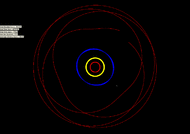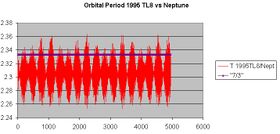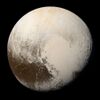Astronomy:(48639) 1995 TL8
| Discovery [1][2] | |
|---|---|
| Discovered by | A. Gleason (Spacewatch) |
| Discovery site | Kitt Peak National Obs. |
| Discovery date | 15 October 1995 |
| Designations | |
| (48639) 1995 TL8 | |
| 1995 TL8 | |
| Minor planet category | TNO [1] · SDO [3] detached [4] · distant [2] |
| Orbital characteristics [1] | |
| Epoch 4 September 2017 (JD 2458000.5) | |
| Uncertainty parameter 2 | |
| Observation arc | 19.30 yr (7,049 days) |
| |{{{apsis}}}|helion}} | 64.486 AU |
| |{{{apsis}}}|helion}} | 39.969 AU |
| 52.227 AU | |
| Eccentricity | 0.2347 |
| Orbital period | 377.45 yr (137,863 days) |
| Mean anomaly | 44.811° |
| Mean motion | 0° 0m 9.36s / day |
| Inclination | 0.2478° |
| Longitude of ascending node | 260.27° |
| 83.589° | |
| Known satellites | 1 (D: 80 km)[5] |
| Physical characteristics | |
| Dimensions | 176 km[5] 420.27 km (calculated)[6] 495 km (estimated)[7] |
| Geometric albedo | 0.07 (estimated)[7] 0.10 (assumed)[6] 0.369[5] |
| RR [8] · C (assumed)[6] | |
| Absolute magnitude (H) | 4.667±0.091 (R)[9] · 5.0[1][6] · 5.1[7] · 5.290±0.060[lower-alpha 1] |
(48639) 1995 TL8 is a binary trans-Neptunian object from the scattered disc in the outermost regions of the Solar System. It was discovered by Arianna Gleason in 1995 and measures approximately 176 kilometers in diameter. Its 80-kilometer minor-planet moon, provisionally designated S/2002 (48639) 1, was discovered on 9 November 2002.[5]
Discovery
1995 TL8 was discovered on 15 October 1995, by American astronomer Arianna Gleason as part of UA's Spacewatch survey at Kitt Peak National Observatory, near Tucson, Arizona.[2]
It was the first of the bodies presently classified as a scattered-disc object (SDO)[3] to be discovered, preceding the SDO prototype (15874) 1996 TL66 by almost a year.[citation needed]
Satellite
A companion was discovered by Denise C. Stephens and Keith S. Noll, from observations with the Hubble Space Telescope taken on 9 November 2002, and announced on 5 October 2005. The satellite, designated S/2002 (48639) 1, is relatively large, having a likely mass of about 10% of the primary. Its orbit has not been determined, but it was at a separation of only about 420 kilometres (260 mi) to the primary at the time of discovery, with a possible orbital period of about half a day and an estimated diameter of 161 kilometres (100 mi).[5]
Scattered–extended object
1995 TL8 is classified as detached object (scattered–extended) by the Deep Ecliptic Survey, since its orbit appears to be beyond significant gravitational interactions with Neptune's current orbit.[4] However, if Neptune migrated outward, there would have been a period when Neptune had a higher eccentricity.
Simulations made in 2007 show that 1995 TL8 appears to have less than a 1% chance of being in a 3:7 resonance with Neptune, but it does execute circulations near this resonance.[10]
Right: The orbital period of 1995 TL8 missing the 7:3 (2.333) resonance of Neptune
Numbering and naming
This minor planet was numbered by the Minor Planet Center on 20 November 2002.[11] As of 2018, it has not been named.[2]
See also
- 3753 Cruithne (orbital circulations due to near resonant perturbations with Earth)
- (131696) 2001 XT254 – to see a proper 3:7 resonance with Neptune
Notes
- ↑ Lellouch (2013): observations on 11 February 2011 gave an absolute magnitude of 5.290±0.060. Summary figures for (48639) at LCDB not found at ADS (2013A&A...557...60L)
References
- ↑ 1.0 1.1 1.2 1.3 "JPL Small-Body Database Browser: 48639 (1995 TL8)". Jet Propulsion Laboratory. https://ssd.jpl.nasa.gov/sbdb.cgi?sstr=2048639. Retrieved 16 November 2017.
- ↑ 2.0 2.1 2.2 2.3 "48639 (1995 TL8)". Minor Planet Center. https://www.minorplanetcenter.net/db_search/show_object?object_id=48639. Retrieved 16 November 2017.
- ↑ 3.0 3.1 Johnston, Wm. Robert (15 October 2017). "List of Known Trans-Neptunian Objects". Johnston's Archive. http://www.johnstonsarchive.net/astro/tnoslist.html. Retrieved 16 November 2017.
- ↑ 4.0 4.1 Marc W. Buie (2003-10-22). "Orbit Fit and Astrometric record for 48639". SwRI (Space Science Department). http://www.boulder.swri.edu/~buie/kbo/astrom/48639.html. Retrieved 2009-01-26.
- ↑ 5.0 5.1 5.2 5.3 5.4 Johnston, Wm. Robert (21 September 2014). "Asteroids with Satellites Database – (48639) 1995 TL8". Johnston's Archive. http://www.johnstonsarchive.net/astro/astmoons/am-48639.html. Retrieved 16 November 2017.
- ↑ 6.0 6.1 6.2 6.3 "LCDB Data for (48639)". Asteroid Lightcurve Database (LCDB). http://www.minorplanet.info/PHP/generateOneAsteroidInfo.php?AstInfo=48639%7C. Retrieved 16 November 2017.
- ↑ 7.0 7.1 7.2 Michael E. Brown. "How many dwarf planets are there in the outer solar system?". California Institute of Technology. http://web.gps.caltech.edu/~mbrown/dps.html. Retrieved 16 November 2017.
- ↑ Belskaya, Irina N.; Barucci, Maria A.; Fulchignoni, Marcello; Dovgopol, Anatolij N. (April 2015). "Updated taxonomy of trans-neptunian objects and centaurs: Influence of albedo". Icarus 250: 482–491. doi:10.1016/j.icarus.2014.12.004. Bibcode: 2015Icar..250..482B. http://adsabs.harvard.edu/cgi-bin/bib_query?bibcode=2015Icar..250..482B. Retrieved 16 November 2016.
- ↑ Peixinho, N.; Delsanti, A.; Guilbert-Lepoutre, A.; Gafeira, R.; Lacerda, P. (October 2012). "The bimodal colors of Centaurs and small Kuiper belt objects". Astronomy and Astrophysics 546: 12. doi:10.1051/0004-6361/201219057. Bibcode: 2012A&A...546A..86P. http://adsabs.harvard.edu/cgi-bin/bib_query?bibcode=2012A&A...546A..86P. Retrieved 16 November 2017.
- ↑ Emel'Yanenko, V. V.; Kiseleva, E. L. (April 2008). "Resonant motion of trans-Neptunian objects in high-eccentricity orbits". Astronomy Letters 34 (4): 271–279. doi:10.1134/S1063773708040075. Bibcode: 2008AstL...34..271E. http://adsabs.harvard.edu/cgi-bin/bib_query?bibcode=2008AstL...34..271E. Retrieved 16 November 2017.
- ↑ "MPC/MPO/MPS Archive". Minor Planet Center. https://www.minorplanetcenter.net/iau/ECS/MPCArchive/MPCArchive_TBL.html. Retrieved 24 February 2018.
External links
- 1999 MPEC listing
- 2000 MPEC listing
- Asteroid Lightcurve Database (LCDB), query form (info)
- Discovery Circumstances: Numbered Minor Planets (45001)-(50000) – Minor Planet Center
- (48639) 1995 TL8 at AstDyS-2, Asteroids—Dynamic Site
- (48639) 1995 TL8 at the JPL Small-Body Database





